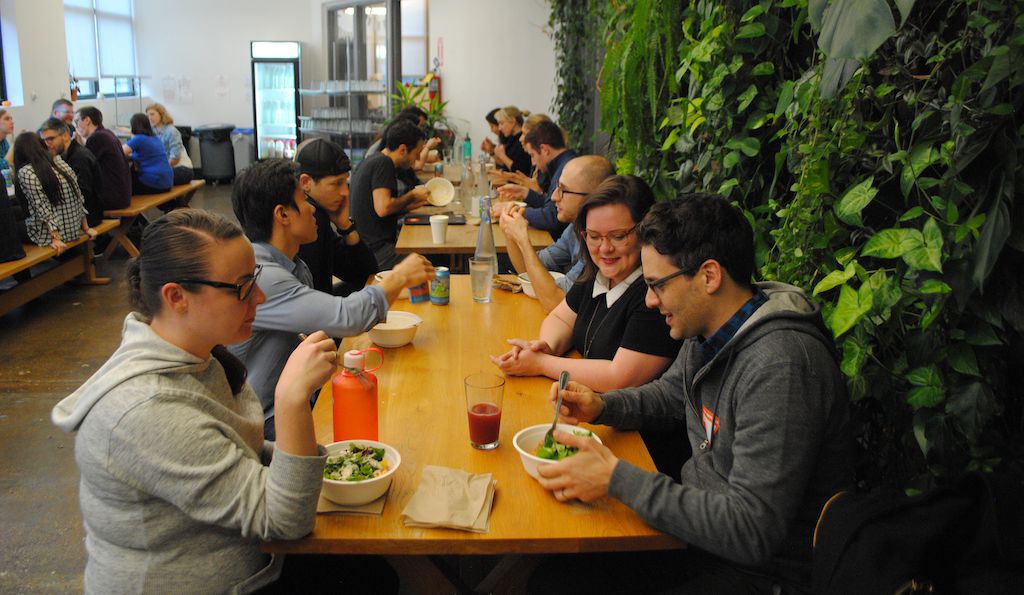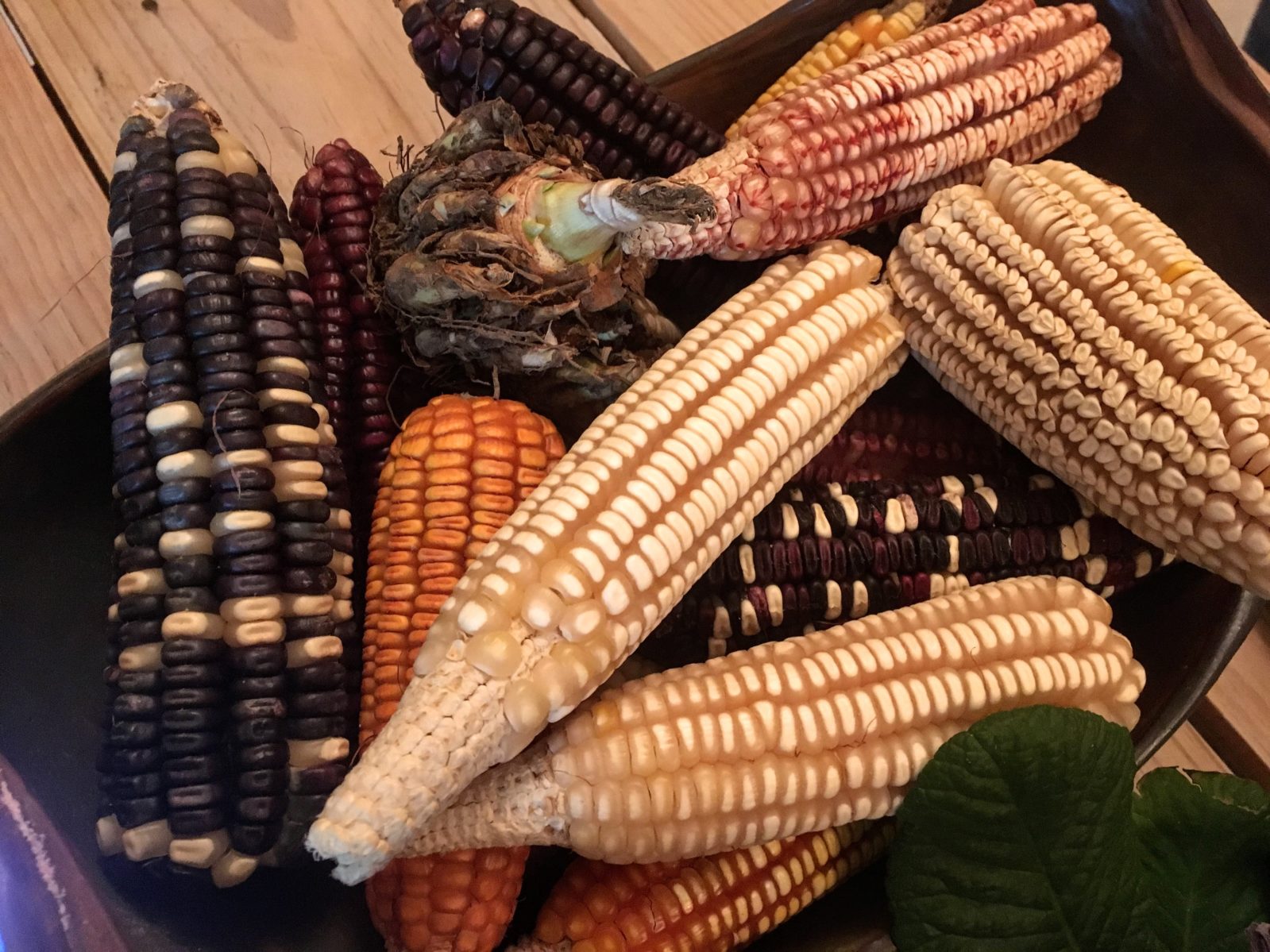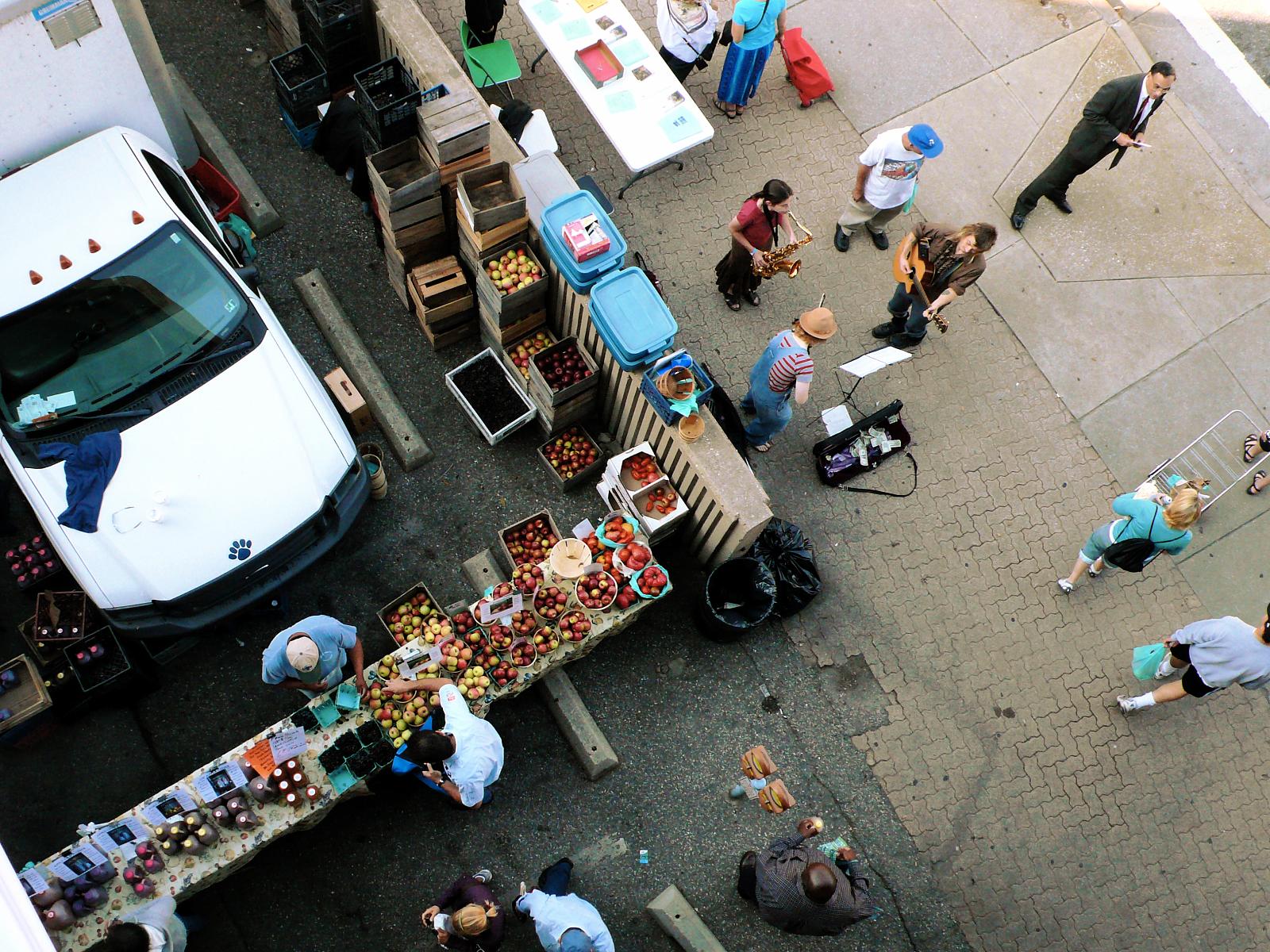
Joe Fassler
It’s a Tuesday in Dumbo, Brooklyn, at the world headquarters of Etsy, the online marketplace for everything handcrafted. Minus the yarn-bombed ceiling vents and tchotchke-laden desks, it could be an everyday tech office: open floor plan, twenty-somethings parked in front of laptops.
But at 12:30, things get a little crazy.
“We have a dinner bell, and people literally come running,” says Katie Rose Crosswhite, Etsy’s Brooklyn food program coordinator. “It’s like the running of the bulls. It is fast and furious.”
They call it Eatsy. The crowd homes in on three long tables, covered end to end in compostable paper bowls. Each single-serving portion, prepared that morning by The Meat Hook, a Williamsburg-based whole-animal butchery and grocery store, contains basically the same thing: a frisee salad, topped with an assortment of roasted vegetables, and a choice of chicken, bacon cubes, or—for the vegetarians and vegans—barbecued tofu skins. The simplicity of the menu allows things to be truly grab and go: most weeks, 300 employees are served in the first 15 minutes.

Etsy staffers help themselves to a recent Eatsy offering: braised BBQ chicken thighs with pickled vegetables and winter greens, courtesy of Brooklyn restaurant Isa
The program feeds Etsy employees all over the world, 400-plus in Brooklyn, and about 350 more in eight other cities worldwide. For the staff, it’s a nice employee perk—a time to step away from the desk and commune with colleagues over a delicious (and free) gourmet meal. But to the organizers, it’s much more: a way to connect with the community, pursue Etsy’s mission of small-scale production, and help give small entrepreneurs a boost.
It’s more than just free lunch. Eatsy’s a fully-fledged small business incubator.
Welcome to Eatsy
Tech companies are notorious for their over-the-top employee perks, including free gourmet food around the clock. Etsy aims a bit lower, serving lunch just twice a week on Tuesdays and Thursdays.
“It’s not your 24/7 cornucopia,” says William Robb, Etsy’s global food program manager. As an Etsy employee, he says, you do have to think about where your next meal’s coming from.
This may be partly a financial decision: Etsy’s no Google or Apple, and its stock has fallen since the company’s April, 2015 IPO (dragged down, in part, by the entrée of Amazon Handmade, a less well-regarded, but better-capitalized competitor).
But there’s also a philosophical reason.
“We’re encouraging employees to go out and support local businesses,” says Ariana Anthony, a member of Etsy’s PR team. “We are a marketplace made up of lots and lots of small parts, and we want to support that kind of mindset in everything we do.”
That mindset translates into a food program that’s both simple and difficult. In one sense, it’s a streamlined operation: Etsy serves two meals a week plus snacks, without corporate chefs or permanent catering contracts, and it’s all done out of a tiny, barebones space—a glorified office kitchen.
But by outsourcing food duties to a growing roster of small companies, Etsy makes a fairly simple corporate function much more complex. Since every lunch—even one served by a frequent collaborator—is dreamed up from scratch, every Eatsy lunch has a lot of moving parts. One perpetual headache: sourcing large, one-time orders of local ingredients.
“The challenge for us is the lead time,” says Meat Hook’s chef Gil Calderon. “Say 100 pounds [of meat] can cover between 250 and 300 people. A hundred pounds for most commodity meat suppliers is a drop in the bucket. But for our farmers and purveyors, it’s kind of a big deal. It actually means they might have to hire people for a couple extra days, or pay overtime.”
Crosswhite’s got to keep these supply-side limitations in mind as she finds vendors, collaborates on menus, and orchestrates the logistics.
A lot of work? Says Crosswhite: “It’s like throwing a wedding twice a week.”
Small businesses, feeding huge crowds
Crosswhite is constantly on the lookout for new vendors. She reads local restaurant reviews, visits events and festivals like Brooklyn’s Smorgasburg food fair, and turns to Etsy staff for tips. She says she’ll consider working with anyone who is generally committed to sustainability, waste reduction, and local sourcing–as long as she loves the food. It doesn’t matter if they’ve never fed 500 people at a sitting.
Crosswhite looks for Eatsy vendors at local events like Smorgasburg, an ongoing “food flea market” in Brooklyn
Sometimes this means working with very inexperienced vendors. “We’ve taught people how to fill out invoices,” Robb says. “We’ve asked people to invoice us who have been like, ‘What?’”
“It’s been a learning process for me and them,” Crosswhite says. “A lot of our caterers never set out to feed hundreds of people in one sitting. But they’ve really shown incredible growth and spirit and willingness to dive in.”
When someone is truly too small for an Eatsy lunch, there are always other options, from private meetings to corporate classes.
“People who can’t handle our numbers yet are perfect for our ‘lunch and learn’ meetings, where we have a lecture and supply lunch for everybody,” Crosswhite says. Another way is through what she calls “elements,” adding a unique twist to a meal catered by another vendor.
“I’ve started tasking some of my regular caterers with finding other small businesses that they can bring in on a lunch,” Crosswhite says. “We’ve set aside part of a budget for that. So a baker, who can make us just the dessert, or a tea shop that can do just the beverage for the meal, can be part of it—even if they don’t specialize in full-scale lunches.”
Then there are snacks. Etsy is big on snacks, which account for about half of the food budget—lunches take the rest. That’s how Navhae Frost got her start with Etsy. Frost, a former literary agent turned private chef, is founder of ElevenThirtySix, a small caterer with a pickup window in Crown Heights, Brooklyn. When Crosswhite first approached her, Frost was getting mostly smaller gigs. At the time, Etsy had only about 200 Brooklyn employees, still far more than ElevenThirtySix could handle for lunch.
So Crosswhite assigned her to snack duty–specifically, popcorn. The day of, Frost woke up at four in the morning and started popping. “You have to get up early and do it that morning if it’s going to be tasty and hot,” she says. She made the delivery at 11 AM, meeting her deadline and reaching a milestone for her business.
“I think I ate popcorn for two days afterwards,” Frost says.
Occasionally, Eatsy hits a snag—probably inevitable, when you’re combining small, inexperienced vendors, the vicissitudes of local food, and a massive crowd of hungry people. But Robb says it’s important to work through the tough times, too.
“There’s a break-in period,” he says. “We want to develop relationships with people. It’s not like, one bad lunch and you’re out of here, sorry.” So if the values align and the food’s good, you’ve got a shot with Etsy—no matter how small the business.
The beauty of the bowl
Here’s Crosswhite’s best tip for anyone involved in corporate catering: Keep it simple, and forget about family-style service. Neil Syham, founder of Lumpia Shack and an Eatsy regular, learned that the hard way. He started selling lumpia—traditional Filipino spring rolls, topped with slow-braised, pastured meats—out of a Smorgasburg food truck, then opened a counter service spot in the West Village. When Crosswhite first asked him to cater Eatsy, it was his biggest single gig ever. “All I remember is it was 350 people and three and a half hours of putting out food,” he says. “And I would just go home and pass out afterward.”
Family service wasn’t just hard work, it made it much harder to feed everyone reliably. “We ran into issues where maybe an employee was taking too much meat, or too much rice or too much salad, and suddenly there wasn’t enough to fulfill 500 covers,” Syham says. These days, the standard is compostable, single-serving bowls, which make it much easier for vendors to plan ahead. When everything’s thrown into the same bowl, employees can’t eat too much or too little of any one ingredient. Vegans and vegetarians each get a spin on that day’s bowl, and allowances are made for a handful of employees with special diets. Beyond that, everyone’s eating the same lunch.
This, of course, limits employee choice–and leaves picky eaters without recourse. But Crosswhite doesn’t care. “My major focus is not whether or not this is your favorite meal,” Crosswhite says. “It’s about whether it’s good for you, energizing, and helps supporting likeminded businesses.”
For vendors, it’s a big improvement. Because of the simplicity, the meals don’t eat up too much staff time. Frost estimates that the total commitment is three and half days of one worker’s time—two and a half days for prep, half a day for administrative stuff like menu planning and sourcing, and half a day for the service itself.
“It’s definitely helped me reconsider the way that I would plan other events for fewer people,” says Frost. “I’ve learned more about scaling from this than I have from anything ever.”
Waste Not
If Etsy’s vendor criteria are a little vague, its food waste reduction goals are not. As a certified B Corporation, Etsy is committed to certain social goals—one of which is to eventually make the entire enterprise waste-free.
In 2014, Brooklyn Etsy employees biked more than 8,000 pounds of food waste and torn-up paper bowls to the Red Hook Community Garden, where it became compost. Though a third of the office’s waste still ends up in the landfill, the rest is recycled or composted. Crosswhite says very little of the waste is food.
“We try to plan so that there’s not too much extra food, and when there is extra food we usually eat it the next day,” Crosswhite says. “It’s very rare that we have any leftovers that go bad.”
(There’s an office in-joke about these day-after servings: the Etsy staff calls them “Reheatsy.”)
But food isn’t the only waste stream Etsy’s closely watching. There’s also throwaway aluminum pans, yards of plastic wrap, countless disposable forks—the everyday casualties of corporate catering. In this regard, vendors must be prepared to do things differently. They aren’t really allowed to throw anything out.
“A lot of times when you’re working catering gigs you need giant trash cans, and all our caterers are allowed to have is a tiny desk trash can,” Crosswhite says. “It’s one of the first things I point out to visiting caterers who are coming by to see the process firsthand.”
“We take stuff in plastic containers that we use for storage anyway,” says Adamson. “We took over two 12-gallon Lexans of salad greens today. Or we use the metal containers—they’re called hotel pans—that we would braise meat in, stuff like that. Today we took over 12 hotel pans of cornbread. We take it over with the food items in it, and we bring it back here and we wash it.”
Scaling up
Successful Etsy vendors gain a large, repeat audience, exposure, and a simple-to-execute menu with low overhead and reduced complexity. It’s a formula that can transform a business.
“Last year we had four caterers that went on to open their own brick-and-mortar restaurants. That, in New York city, is no small feat,” Crosswhite says. “We are in line to have a handful more this year.”
“It’s huge,” Adamson says. “It frees us up from some of our built-in costs to be able to explore other things.” She says that consistently doing Eatsy has allowed Vinegar Hill House to donate meals to charity and put more money into promotional events—things they wouldn’t be able to do without the contract. It even gave them enough of a buffer to do some renovations.
“We had to close for three days because we did some renovations over the Labor Day holiday. This helped us make back some of that revenue that we lost.”
For Frost—who does two Eatsies a month—it’s been about the visibility.
“It’s been really helpful to work with them as regularly as we have, especially in an industry that’s pretty freelance. You don’t know where your next job’s coming from.” She means that catering events are often a one-shot deal: “People only get married one time, generally speaking,” she says.
For Crosswhite, it’s about making connections. “I love being able to pass off a list of great, responsible trustworthy vendors for folks for their personal lives, and to continue to add fuel to those relationships,” she says. “Then they go and they tell their friends. The ripple is real and palpable, even if I don’t get invited.”
Meanwhile, Robb takes the lessons he and Crosswhite have learned in Brooklyn, and applies them to Etsy’s offices when he can—though each location has a distinct set of needs.
“Everybody’s at a different scale,” Robb says. “Here, we’re feeding 500 people and it’s a madhouse. In Toronto, it’s small enough that it’s basically takeout.”
Each city has its own local food system, too, with a unique cast of characters and region-specific challenges. This means that, to some degree, every office has to find its own way.
“Local food isn’t something you can do by remote control from headquarters,” he says. “My role is to figure out how to help each office put down roots in its own community and find connections to whatever their local food system is doing. Every place is in a different phase in terms of where their local food system is and, if you’re going to foster it, where the leverage points would be.”
Though you can already buy food products from Etsy sellers, it’s not a currently a big focus for the company. But Robb thinks that may start to change.
“Long term I’d like to see us [further] integrate food onto the Etsy platform,” he says. “We’re not there operationally yet. But we talk about Etsy being a marketplace made up of very small things. I think a lot about how can we build a food program that’s built on the same notion.”
It’s ambitious, but not impossible. After all, Eatsy began as a modest employee benefit—twelve people ordering takeout around a picnic table, way back in 2005; today, it’s a major catering client, closely with roots in nine local food economies worldwide. If Robb has his way, Etsy’s work in food is far from finished.





















